Physics For Civil Engineering: Unit III: Acoustics and Lighting Designs
Acoustics
Definition, Classification of Sound, Musical Sound and its Characteristics, Noise, Loudness, Decibel
Methods of sound absorptions absorbing materials noise and its measurements, sound insulation and its measurement, impact of noise in multi-storeyed buildings.
Unit
– III
Acoustics and Lighting Designs
Acoustics
Methods
of sound absorptions absorbing materials noise and its measurements, sound
insulation and its measurement, impact of noise in multi-storeyed buildings.
Introduction
The branch of physics which deals with
generation, reception, propagation and analysis of sound is called acoustics.
The
study of sound waves plays an important role in many engineering and non-engineering
applications. The areas of acoustical studies and their applications include
Architectural
acoustics - Study of sound waves in closed halls and buildings.
Musical acoustics - Physics
of musical instruments?
Engineering
acoustics - Technology y of sound production
production and recording, study of vibrations of solids and their control as
well as noise control.
Bio-acoustics / Medical acoustics - Use of sound in medical diagnosis
and therapy.
Classification of Sound
Sound
waves are classified into three types based on their frequencies.
(a) Infrasonics (Inaudible): Sound waves of frequencies below 20 Hz are called infrasonics. They are
inaudible.
(b)
Audible sound: Sound waves of frequencies between 20 Hz and 20,000 Hz are called audible sound. They are audible.
Audible
sound is further classified as musical sound and
(c)
Ultrasonics (Inaudible): Sound waves of frequencies above 20,000 Hz or 20 kHz are called ultrasonics. They are inaudible.
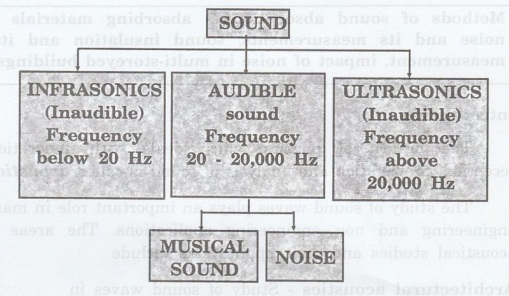
Musical Sound
Sound which produces a pleasant effect
to our is called musical sound.
Example:
Sounds
produced by the musical instruments like sitar, violin and piano are musical
sounds.
Properties
of musical sound
• Fig.
3.1. shows the wave forms of the different musical sounds.
• The
waveform of musical sound has a regular shape.
•
Musical sound has definite periodicity.
• There is no sudden change in
amplitude.
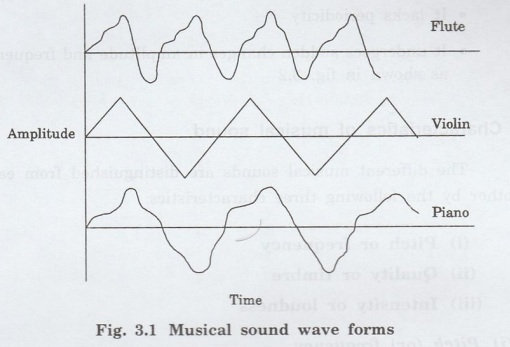
Noise
Any
unpleasant sound to our ears is called noise.
Noise
causes irritation and strain to our ear. Noise of high intensity may cause
permanent or temporary deafness.
Example:
Movement of furniture, road traffic, explosion of bombs.
Properties
of noise
•
The wave form of noise is shown in fig. 3.2.
• The waveform of noise is irregular in
shape
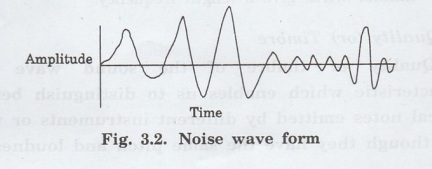
•
It lacks periodicity
•
It undergoes sudden changes in amplitude and frequency as shown in fig. 3.2
Characteristics of musical sound
The
different musical sounds are distinguished from each other by the following
three characteristics.
(i) Pitch or frequency
(ii)
Quality or timbre
(iii)
Intensity or loudness
(i) Pitch (or) frequency
Pitch
is the characteristic of a sound which distinguishes between a shrill sound and
a grave sound. The pitch of a musical note is the
sensation conveyed to our brain by the sound waves falling on our ears.
Pitch
depends directly on the frequency of the sound waves.
Example
•
The voice of women and children has high pitch because the frequency of sound
is high.
•
The voice of an old man has low pitch because the frequency of sound is low.
•
In
guitars, thicker wires give a lower frequency and thinner wires give a length
frequency.
(ii) Quality (or)
Timbre
Quality
or timbre of the sound wave is a characteristic which enables us to distinguish
between musical notes emitted by different instruments or voices even though
they have the same pitch and loudness.
(iii) Intensity of sound (I)
Intensity
of a sound wave (I) at a point is defined as the amount of sound energy (Q)
flowing per second per unit area held normally at the point to the direction of
the propagation of sound wave.
Intensity
of sound wave I = Q / tA
where
Q Amount of sound energy flowing
t-
Time of flow
A
- Area normal to the propagation of sound.

Intensity
is a measurable physical quantity. It is expressed in joule second-1
metre -2or watt metre (Wm-2).
Loudness
Loudness
of the sound is defined as the degree of sensation produced on the ear. It
varies from one listener to another. Loudness is different from intensity of
sound.
Loudness
is a physiological quantity. It is difficult to measure because it depends upon
the individual listener. However, it is measured as the logarithmic value of
intensity.
Weber
- Fechner Law
(Relation
between loudness and intensity of sound)
According to Weber - Fechner law, the
loudness of sound varies with intensity of sound.
Statement
The law states that the loudness (L)
produced is directly proportional to logarithm of intensity.
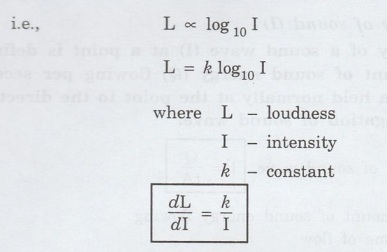
The
quantity ![]() is called sensitiveness of the ear. It decreases with an
increase in the intensity of sound.
is called sensitiveness of the ear. It decreases with an
increase in the intensity of sound.
Sound
Intensity Level
Absolute intensity of a sound wave is
measured in Wm2. For all our practical purposes, we are interested in the measurement
of relative intensity rather than absolute intensity.
Intensity
of a sound is measured with reference to some standard intensity. The standard
intensity I = 10 Wm 1S chosen for this purpose.
This
is the lowest intensity of sound (at 1000 hertz) to which a normal human ear
can respond. This standard intensity is known as threshold of audibility.
Decibel
Definition
The
logarithmic ratio of intensity of a sound to standard intensity is known as
sound intensity level or relative intensity of sound.
The,
sound intensity level of a sound wave having intensity I is given by

Here,
standard intensity of sound is the minimum audible sound intensity heard by our
ears.
The
unit for sound intensity level is bel named in honour of Alexander Graham Bell,
(inventor of telephone).
Sound intensity level, ẞ = log 10 [I/IO] ……………….....(2)
Consider
sound intensity I = 101。
Sound
intensity level in bel, ẞ = log 10[10 I O/IO]……………..(3)
From
equation (3), we get

If I = 100 IO, then ẞ = 2
bel, and
If
I = 1000 IO, then ẞ = 3 bel.
Bel
is the sound intensity level of a sound whose intensity is ten times the
standard intensity.
In practice, bel is a larger unit.
Hence, another unit known as decibel (dB) is more often used.
1 bel = 10 decibel
Hence,
sound intensity level is measured in decibel
ẞ
(in decibel) =
10 log10 [I/IO] dB
Physical
significance of a decibel
Let
us find the physical significance of a decibel, i.e., what percentage change in
intensity represents one decibel.
If sound intensity level increases by
'1' dB, (substituting intensity level in dB = 1)
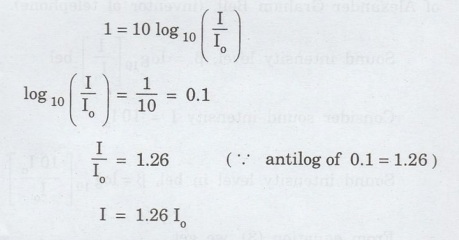
Thus,
an increase of sound intensity level by 1 dB would increase the intensity by
26%.
Normally,
our ears can hear the sound intensity level between the range 0 dB to 120 dB.
The maximum sound intensity level which our ears can tolerate without sensation
of pain is 120 dB. This upper limit of hearing is called threshold of feeling
or pain threshold.
Physics For Civil Engineering: Unit III: Acoustics and Lighting Designs : Tag: : Definition, Classification of Sound, Musical Sound and its Characteristics, Noise, Loudness, Decibel - Acoustics
Related Topics
Related Subjects
Physics for Civil Engineering
PH3201 2021 Regulation | 2nd Semester Civil Dept 2021 Regulation
